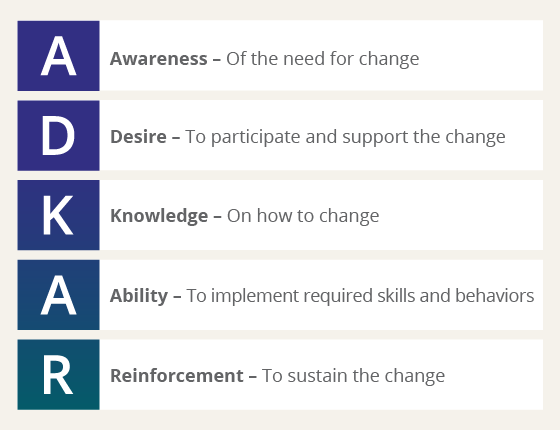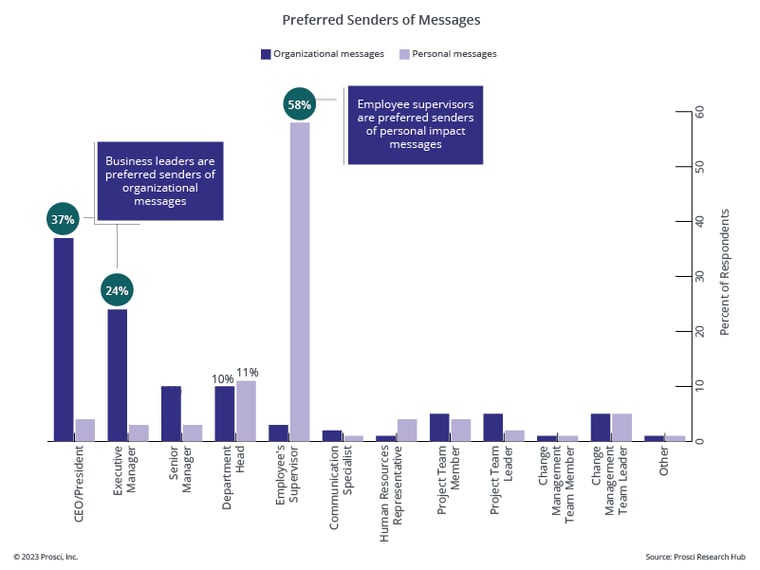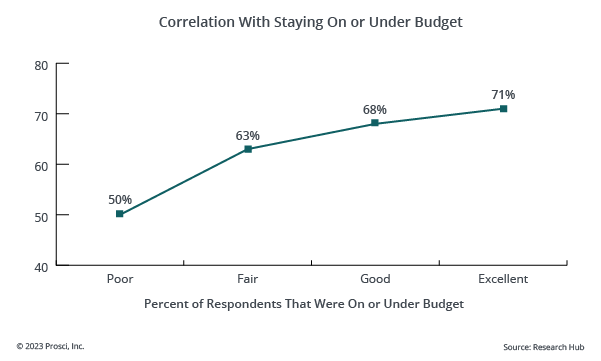
The People Side of Change
Change management addresses the people side of change. Creating a new organization, designing new work processes, and implementing new technologies may never see their full potential if you don't bring your people along. That's because financial success depends on how thoroughly individuals in the organization embrace the change.
Change management is the application of a structured process and set of tools for leading the people side of change to achieve a desired outcome. Ultimately, change management focuses on how to help people engage, adopt and use a change in their day-to-day work.
When defining change management, we recognize it as both a process and a competency.
Change Management as a Process
The change management process enables practitioners within organizations to leverage and scale the change management activities that help impacted individuals and groups move through their transitions. The Prosci Methodology includes a robust, research-based process called the Prosci 3-Phase Process:
During Phase 1 – Prepare Approach, we ask and answer:
- What are we trying to achieve?
- Who has to do their jobs differently and how?
- What will it take to achieve success?
During Phase 2 – Manage Change, we ask and answer:
- What will we do to prepare, support and engage people?
- How are we doing?
- What adjustments do we need to make?
And during Phase 3 – Sustain Outcomes, we ask and answer:
- Now, where are we? Are we done yet?
- What is needed to ensure the change sticks?
- Who will assume ownership and sustain outcomes?
Change Management as a Competency
At the organizational level, change management is a leadership competency for enabling change within an organization. It is also a strategic capability designed to increase the change capacity and responsiveness of the organization.
For senior leaders, change management competency means being able to lead change for the organization, including being an effective sponsor of change and demonstrating commitment to the change, both individually and organizationally. For people managers working with front-line employees, competency relates to effectively coaching direct reports through their change journeys. Although competency varies according your relationship to change, organizations are more effective and successful when they build change management competencies throughout their ranks.
Change management is not just communication and training. Nor is it simply managing resistance. Effective change management follows a structured process and employs a holistic set of tools to drive successful individual and organizational change.
Why Do We Need Change Management?
There are numerous reasons to employ effective change management on both large- and small-scale efforts. Here are three main reasons:
- Organizational change happens one person at a time
- Ignoring the people side of change is costly
- Change management increases the likelihood of success
Organizational change happens one person at a time
It is easy to think about change only from an organizational perspective. When you consider a merger or acquisition, you might focus on financial structuring, data and systems integration, and physical location changes. However, organizational change of any kind occurs one person at a time. That is because an organization-wide change only occurs when Andre, Becky, Carlos and Dharma do their jobs differently.
Organizations don’t change, people do. It is the cumulative impact of successful individual change that brings about successful organizational change. If individuals don’t make changes to their day-to-day work, an organizational transformation effort will not deliver results.
Ignoring the people side of change is costly
Poorly managing or ignoring the people side of change has many consequences:
- Productivity declines on a larger scale for a longer duration than necessary
- Managers are unwilling to devote time or resources needed to support the change
- Key stakeholders do not show up to meetings
- Suppliers begin to feel the impact and see the disruption caused by change
- Customers feel negative impacts of a change that should have been invisible to them
- Employee morale suffers and divisions between “us” and “them” begin to emerge
- Stress, confusion and fatigue increase
- Valued employees leave the organization
Projects also suffer from missed deadlines, budget overruns, rework and even abandonment. These consequences have tangible impacts on project health and the organization. Fortunately, you can mitigate these issues when you deploy a structured approach to the people side of change.
Change management increases the likelihood success
A growing body of data shows the impact effective change management has on the probability of a project meeting objectives. Prosci’s Best Practices in Change Management benchmarking studies revealed that 88% of participants with excellent change management met or exceeded objectives, while only 13% of those with poor change management met or exceeded objectives.

In other words, projects with excellent change management were seven times more likely to meet objectives than those with poor change management. What may be most enlightening about the research is that poor change management correlates with better success than applying none at all.
Prosci research even shows a direct correlation between effective change management and staying on schedule and on budget.
Individual vs. Organizational Change Management
Effectively managing change requires two perspectives: an individual perspective and an organizational perspective.
Individual Change Management
The individual perspective is an understanding of how people experience change. Prosci’s ADKAR Model describes successful change when an individual has:
 If an individual gets stuck on a building block and cannot progress sequentially through the model, the change will not be as successful. The goal in leading the people side of change is ensuring that individuals have Awareness, Desire, Knowledge, Ability and Reinforcement.
If an individual gets stuck on a building block and cannot progress sequentially through the model, the change will not be as successful. The goal in leading the people side of change is ensuring that individuals have Awareness, Desire, Knowledge, Ability and Reinforcement.
Organizational Change Management
The organizational perspective of change management is the process and activities that project teams use to support successful individual change. If the ADKAR Model describes what an individual needs to make a change successfully, organizational change management is the set of actions to help build Awareness, Desire, Knowledge, Ability and Reinforcement across the organization. The Prosci Methodology is based on more than two decades of research and includes assessments and strategies to support targeted change management plans:
- Master Change Management Plan
- ADKAR Blueprint
- Core Plans
- Role-based plans
- Sponsor Plan
- People Manager Plan
- Activity Plans
- Communications Plan
- Training Plan
- Role-based plans
- Extend Plans, as required
- Resistance Management Plan
- Change Agent Network Plan
- Sponsor Coalition Plan
- Sustainment Plan
- Other custom plans
Change Management Roles
The change practitioner is like the director of the play working behind the scenes to enable actors on the stage. As a change enabler, the practitioner works to develop the change management strategy and plans while supporting and equipping senior leaders and people managers to fulfill their unique, employee-facing roles.
For example, research shows that employees prefer to receive organizational messages about change from leaders at the top of their organization and messages about the change's impact on their day-to-day work from their immediate supervisor.
The practitioner's job is to enable key leaders and people managers to perform these and other employee-facing roles effectively. During times of change, the effectiveness of senior leaders and people managers in these critical roles will determine whether a project or initiative succeeds or fails.
Change practitioners can enable key roles even more effectively with Kaiya, Prosci's AI assistant. A tool that streamlines the change management process and empowers change practitioners, Kaiya provides on-demand support and insights tailored for unique needs and change initiatives, and answers unique questions on the spot.

How You Can Effect Successful Change
What can you do to become a more effective change leader? Begin applying change management on your projects and build change management competencies in your organization. These are the first steps to ensuring projects deliver their intended results.
The people side of change is not the soft side; it is the harder side. Investing the time and energy to manage the people side of your organizational efforts pays off in the end in terms of your effort's success and avoiding the numerous costs that plague poorly managed change.






